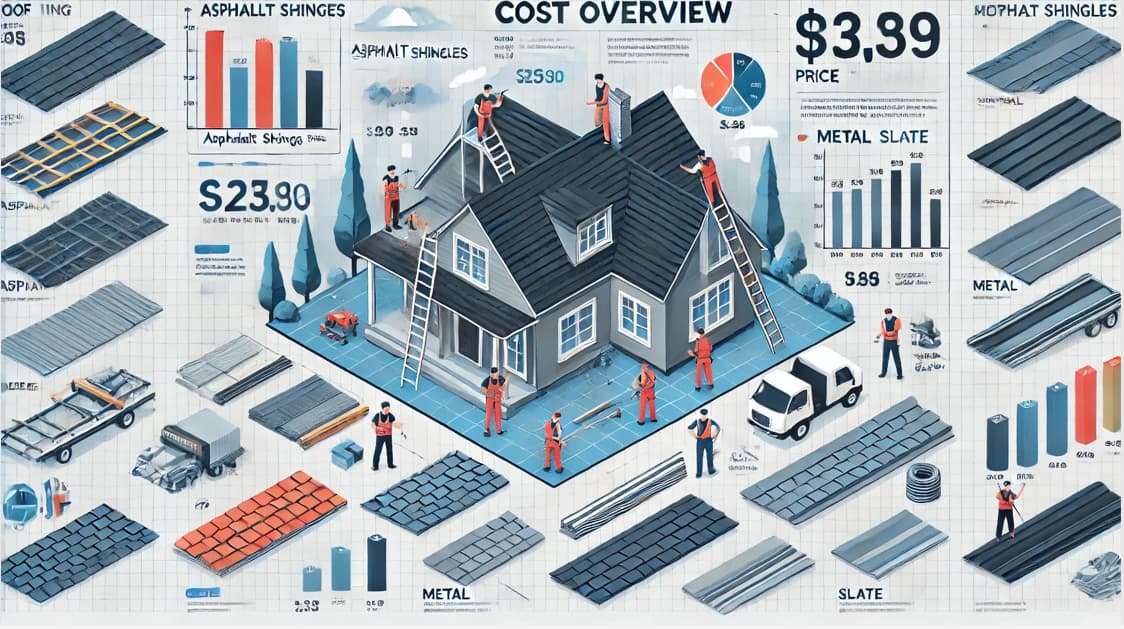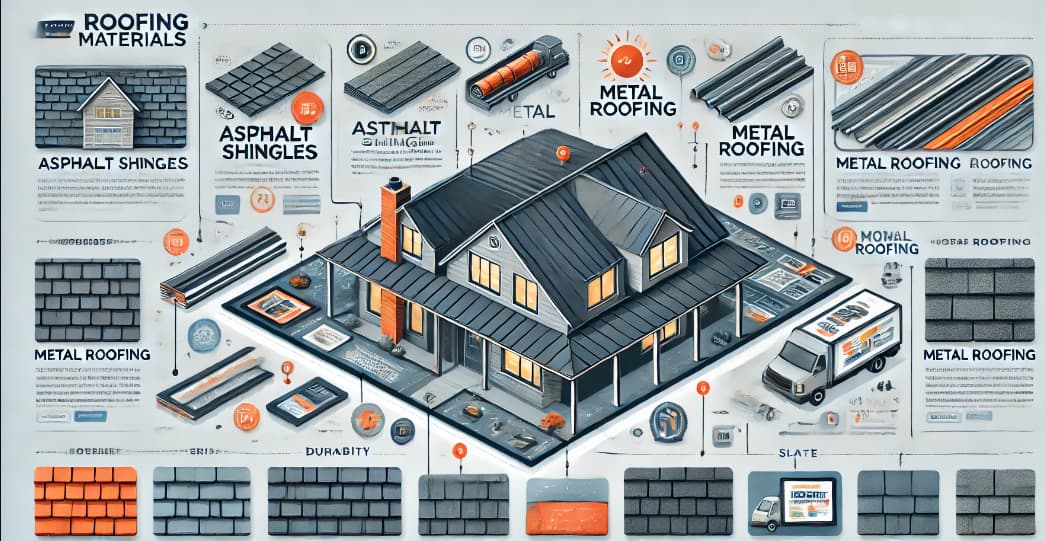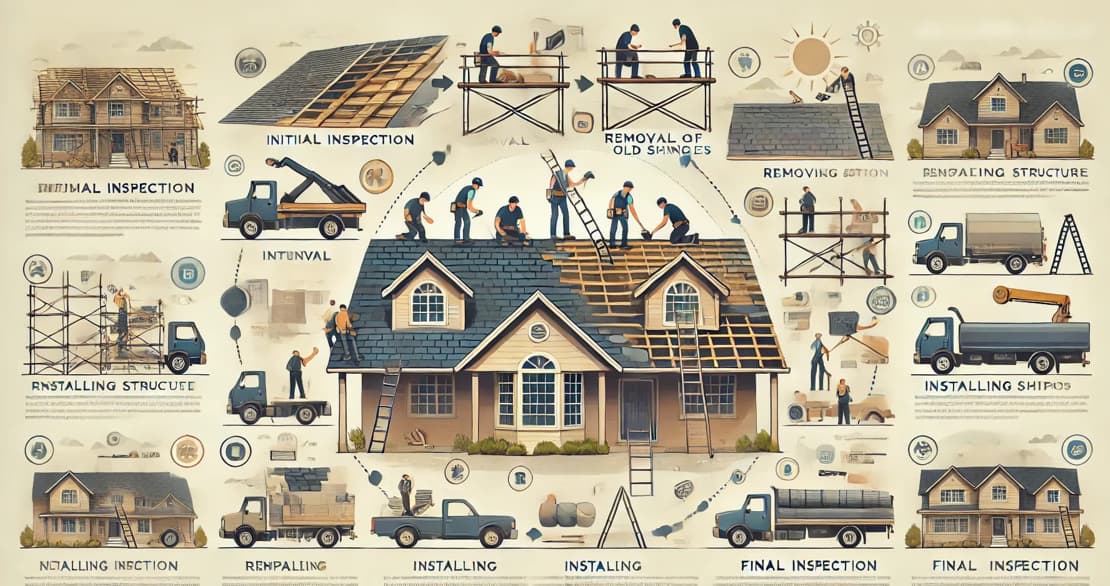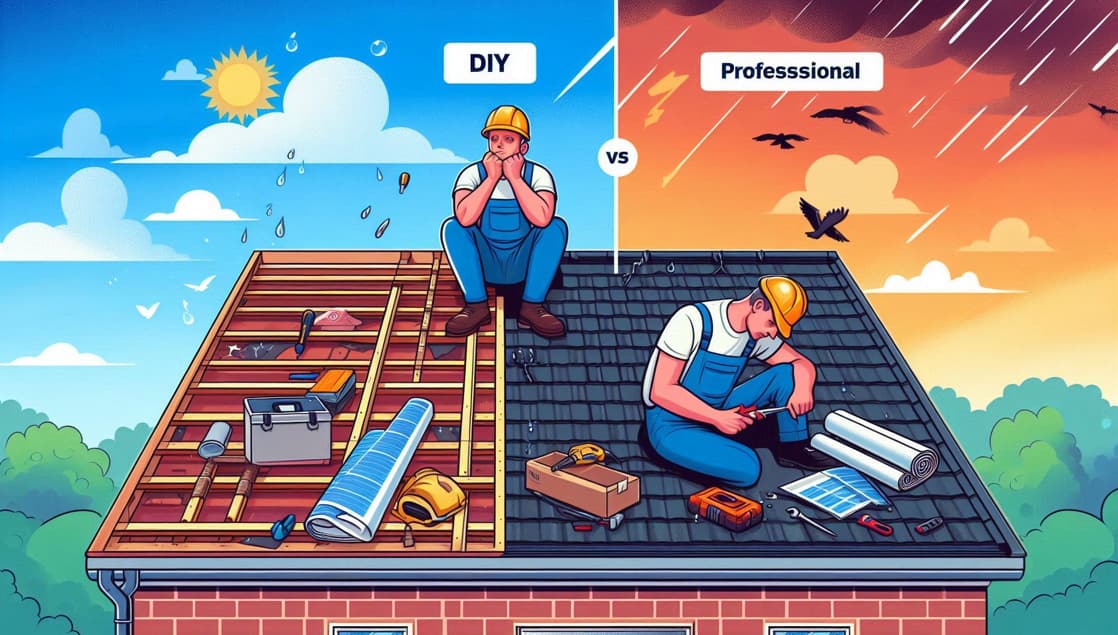Repair
Roof Replacement Essentials: Protect Your Home
Roof Replacement? Replacing your roof is more than a maintenance task. It’s a reinvestment in your home’s safety and curb appeal.
Understanding when and how to undertake this significant home improvement can save you money and prevent potential disasters.
From selecting the right materials to choosing the best season for the work, we provide a comprehensive guide to navigate this crucial project. For essential tools and resources, > check out <.
2. Signs You Need a New Roof
Identifying the need for a new roof is critical to prevent extensive damage to your home. Here are detailed indicators that it might be time to consider a roof replacement:
Curling Shingles:
Shingles that curl, known as cupping (edges turning upward) or clawing (centers coming up), indicate aging and exposure to excessive heat. This deterioration compromises the roof’s ability to shed water and can lead to leaks.
Gutter Granules:
Check your gutters for shingle granules. A healthy amount of granules protects against UV rays and weather.If your gutters are loaded with granules, it means your roof is losing its protective layer, signaling the nearing end of your roof’s life cycle.
Cracked Shingles:
High wind areas often lead to cracked shingles. While a few cracked shingles can be replaced, widespread cracking suggests a more systemic issue that might require a full roof replacement.
Age of the Roof:
Most roofs are designed to last 20 to 25 years. If yours is approaching or has surpassed this age, it’s wise to start planning for a replacement. The older the roof, the more likely it is to fail.
Visible Light in the Attic:
Go up to your attic during daylight. If you see light streaming in, it means there are holes or gaps in the roof. These openings can let in more than light; water and small pests can also enter, leading to additional problems.
Sagging:
A sagging roof is a serious issue. It’s often an indicator of structural problems, possibly in the roofing material or the supports in the attic.
This could be from long-term water damage or a structural flaw. A sagging roof requires immediate attention to prevent potential roof collapse.
Water Damage or Leaks:
The most obvious sign that you need a new roof is when you have active leaks. If you notice water stains on your ceiling, especially after rain, it’s a clear indicator that your roof system is failing.
Moss and Algae Growth:
While moss and algae are more of a cosmetic issue, significant growth can trap moisture and degrade the roof over time, especially in cold climates.
Monitoring these signs and addressing them promptly can significantly extend the life of your roof and protect your home.
For top-rated roofing materials and installation services, check out our partners. This proactive approach ensures you’re not caught off-guard by sudden roof failures.
3. Cost Overview
Replacing a roof involves significant financial planning. Costs vary widely based on materials, roof size, and regional labor rates. Here are common factors affecting the price:
Material Costs:
Asphalt shingles are the most economical, generally costing between $5,000 and $10,000 for an average-sized home. Premium materials like metal or slate can significantly increase the cost.
Size of Roof:
The larger your roof, the more materials and labor will be needed, which raises the cost. Roofing costs are typically calculated per square foot.
Labour:
Labor can vary depending on the complexity of the installation and the geographic location. Steeper roofs require more time and safety measures, increasing labor costs.
Additional Costs:
Consider costs for removing the old roof, disposing of materials, and potential repairs to the roof structure.
See Our Comprehensive Cost Comparison Table Here for a detailed breakdown and find great deals on quality roofing materials.
4. Material Options
Choosing the right roofing material impacts both the cost and longevity of your roof. Here’s a closer look at popular options:
Asphalt Shingles:
The most common choice due to their cost-effectiveness and easy installation. They typically last 20-30 years.
Metal Roofing:
Offers durability with a lifespan of 40-70 years. Metal roofs are more expensive initially but can provide better long-term value through energy savings and minimal maintenance.
Slate:
A high-end option known for its natural appearance and longevity, often lasting over 100 years. However, it is one of the most expensive roofing materials.
For those considering a durable and energy-efficient option, explore our selection of metal roofing. Metal roofs are available in various styles and colors to match any home’s architecture and design preferences.
5. Tear Off vs. Second Layer
When considering a roof replacement, homeowners face a critical decision: whether to tear off the existing roof or simply add a new layer of shingles over the old. Each method has its advantages and drawbacks:
Tear Off Method:
Pros:
- Allows for a thorough inspection of the roof deck and underlying structures for damage.
- Ensures a longer lifespan for the new roof as it is laid on a clean, smooth surface.
- Removes additional weight from the building, which can improve structural stability.
Cons:
- More labor-intensive and time-consuming, increasing the project’s cost.
- Generates more waste, requiring disposal and possibly increasing environmental impact.
Second Layering:
Pros:
- Faster and less expensive since there is no need to remove the old roofing.
- Less labor and reduced need for disposal, lowering the overall environmental impact.
Cons:
- Adds extra weight to the roof structure, which could be problematic for older homes.Can mask underlying problems like rotted decking or leaks, which may cause more serious issues later.
- Typically results in a shorter lifespan for the new roof due to potential uneven surfaces and heat retention.
- Choosing the best option depends on several factors, including the condition of the current roof, budget constraints, and long-term planning for the home.
For homes where the existing roof is in poor condition or has already been re-roofed, a complete tear-off might be necessary to maintain structural integrity and ensure the longevity of the new roof installation.
6. Choosing the Right Time for Roof Replacement
Timing is crucial when planning a roof replacement. Weather conditions greatly influence the installation process and the longevity of your roof. Here’s why late spring and early fall are considered optimal times:
Ideal Weather Conditions:
During these periods, the weather is typically milder with moderate temperatures. This is beneficial because:
Adhesive Performance:
Roofing materials, especially shingles, rely on a thermal sealing process. Moderate temperatures ensure that the adhesive bonds effectively, which is critical for preventing wind uplift and leaks.
Installer Comfort and Safety:
Cooler, comfortable temperatures reduce the risk of overheating and dehydration among the crew, which can lead to faster completion and fewer installation errors.
Material Handling:
Certain roofing materials, like asphalt shingles, become brittle and hard to work with in cold weather and overly pliable in hot temperatures.
Spring and fall provide the perfect balance for easy handling and installation.
Avoiding Extreme Weather:
Roofing during these times helps avoid the summer heat and winter cold, which can complicate the installation process with:
Summer Challenges:
High temperatures can cause materials to expand and become too flexible, complicating installation and potentially leading to premature aging.
Winter Challenges:
Cold weather can make shingles brittle and more likely to crack during installation. Additionally, sealants may not adhere properly, increasing the risk of leaks.
Scheduling your roof replacement during these optimal times can lead to a smoother installation process and a longer-lasting roof.
Homeowners should consult with professional roofers to plan the project according to local climate conditions and to ensure that the installation aligns with these ideal periods.
7. The Roof Replacement Process
The process involves several steps:
Replacing a roof is a structured and detailed process that involves several critical steps.
Understanding each phase can help homeowners prepare and ensure that the project is completed efficiently and effectively. Here’s what to expect:
Initial Inspection and Estimate:
- A professional roofer will first assess the condition of your existing roof. This involves checking for damage, measuring the roof area, and identifying specific needs or challenges.
Based on this inspection, you’ll receive an estimate that outlines the cost and timeline for the replacement.
Choosing Materials:
- Once the estimate is approved, the next step is selecting the materials. This will include the type of shingles or other roofing materials, underlayment, and any additional components like flashing or gutter systems.
Homeowners can explore options through suppliers, often using affiliate links provided for direct purchase or more information.
Preparation and Delivery of Materials:
- Before the actual roofing work begins, all chosen materials are ordered and scheduled for delivery.
- Proper scheduling ensures that the project does not face delays waiting for materials.
Removing the Old Roof:
This phase involves stripping away all old shingles, tiles, or roofing material down to the deck. It’s a crucial step to inspect the underlying structure for any hidden damage like rot or mold, which should be repaired before installing the new roof.
Installing Underlayment:
After cleaning the roof deck, an underlayment is laid down. This acts as a barrier against water and helps protect the deck from the elements. It’s essential for ensuring the longevity of the roof.
Roof Installation:
The new roofing material is then installed. This process varies depending on the type of roofing chosen but generally includes laying, fitting, and securing the roofing material.
For shingle roofs, this involves nailing down the shingles in an overlapping pattern to ensure coverage and protection.
Finishing Touches:
- Once the main roofing is complete, additional components such as flashing, ridge vents, and gutters are installed.
These elements are crucial for the roof’s functionality, preventing water penetration and ensuring proper ventilation.
Cleanup and Final Inspection:
- After the installation, the site is cleaned of any debris, nails, and leftover materials.
The roofing contractor will conduct a final inspection to ensure the roof is installed correctly and to address any concerns the homeowner may have.
Warranty and Follow-Up:
- Most roofing jobs come with a warranty for materials and labor. Ensure you understand the terms of the warranty and keep all related documentation.
Some roofers also offer a follow-up inspection after a few months to check on the roof’s condition and address any settling issues.
Understanding these steps helps homeowners ensure that their roof replacement is handled professionally from start to finish.
8. DIY vs. Professional Installation
Deciding between a DIY project and hiring a professional for roof replacement involves weighing several factors. Here’s a breakdown to help homeowners make an informed choice:
Skill Level:
- Roof replacement is complex and requires specific skills. Professionals have the training and experience to handle unexpected challenges, such as structural damage or unexpected weather changes.
Unless you have experience in roofing, a DIY approach might lead to errors that compromise the roof’s integrity.
Safety Concerns:
- Roofing is a high-risk task that involves working at heights with potentially hazardous tools and materials.
Professional roofers are equipped with safety gear and are trained to work safely in these conditions. DIY roof replacement increases the risk of falls or injuries.
Time Commitment:
- Roofing projects require a significant time investment, especially if you’re learning as you go. Professionals can complete the job more quickly due to their skills and team size.
For homeowners, a DIY project might extend over many days or weeks, leaving the home vulnerable to weather damage.
Cost:
- While DIY might seem less expensive, it can actually cost more in the long run. Mistakes during installation may require additional materials or even professional intervention to fix.
Furthermore, DIY installations typically do not come with warranties, whereas professional work does.
Quality and Longevity:
- Professional installations are likely to be of higher quality due to the expertise and quality materials used.
This quality contributes to the longevity of your roof, potentially saving you money on future repairs or replacements.
Tools and Equipment:
- Professionals come equipped with the necessary tools and equipment, which are often specialized and expensive to purchase.
DIY roofers may need to invest significantly in the right tools for the job, adding to the overall cost.
Warranties and Insurance:
- Professional roofers usually offer warranties on both materials and labor. They are also insured, which protects you from liability in case of accidents.
DIY roof projects lack these protections, which could result in additional costs if something goes wrong.
9. Additional Costs and Considerations
When planning for a roof replacement, there are several additional costs and considerations that homeowners should be aware of to ensure a comprehensive budget and no surprises:
Permits:
- Depending on the location, you may need a permit to replace your roof. Permit fees vary by municipality and can affect the overall cost of the project.
Roof Inspection:
- Before any work begins, a thorough roof inspection by a qualified professional can identify underlying issues that may affect the new roof’s installation and longevity.
This inspection can add to the initial expenses but is crucial for a successful replacement.
Unexpected Repairs:
- During the replacement process, unforeseen problems such as structural damage, rot, or mold may be uncovered, particularly in older homes.
These issues must be addressed before the new roof is installed, potentially adding to the total cost.
Gutters and Downspouts:
- Sometimes, it’s also necessary to replace gutters and downspouts in conjunction with the roofing project.
While this can increase the expense, doing so ensures that all components work together to protect your home from water damage.
Landscaping Protection:
- The process of removing an old roof and installing a new one can pose risks to your landscaping. Protective measures may be needed to safeguard your plants and garden, which can incur additional costs.
Waste Disposal:
- Proper disposal of old roofing materials requires renting a dumpster or arranging for waste removal services, which adds to the project’s cost.
Premium for Emergency Services:
- If your roof replacement is urgent (e.g., due to storm damage), you might face higher costs for expedited services.
Increased Insurance:
- Upgrading your roof may lead to changes in your home insurance premiums, especially if the new roof is made of materials that are more durable or fire-resistant.
Energy Efficiency Rebates:
- Some roof materials, especially those that are energy efficient, may qualify for government rebates or incentives. These can offset some of the upfront costs and provide long-term savings on energy bills.
Aesthetic Choices:
- Opting for premium materials or specialized designs can significantly increase costs but add to the home’s value and aesthetic appeal.
By considering these additional costs and planning for them in advance, homeowners can create a more accurate budget for their roof replacement project and avoid unexpected expenses.
10. Maintenance Tips Post-Replacement
After installing a new roof, proper maintenance is essential to extend its lifespan and maximize your investment. Here are some key maintenance tips to keep your roof in top condition:
Regular Inspections:
- Schedule bi-annual inspections with a professional to catch and address any potential issues early. Check after major weather events as well.
Clean Gutters Regularly:
- Ensure gutters and downspouts are free from debris to prevent water buildup that can damage the roof structure.
Trim Overhanging Branches:
- Cut back any tree branches that could scrape or damage the roof during high winds.
Monitor for Moss and Algae:
- These can retain moisture and cause damage over time. Use appropriate products to clean the roof without damaging its material.
Check for Damage Regularly:
- Look for signs of damage, such as cracked or missing shingles, and address these issues promptly to prevent further deterioration.
Ensure Proper Ventilation:
- Good attic ventilation prevents heat and moisture buildup that can weaken the roof structure and decrease its lifespan.
Sealant and Flashing Checks:
- Regularly check and, if necessary, replace sealants and flashing around vents, chimneys, and skylights to prevent leaks.
Avoid Walking on the Roof:
- Minimize foot traffic to prevent wear and tear. Use professional services when necessary.
Snow and Ice Removal:
- In colder climates, remove snow and ice accumulations promptly to prevent structural damage from the weight and potential ice dams.
Keep Records:
- Maintain a file of all inspections, repairs, and maintenance activities. This documentation can be useful for warranty claims and future selling points.
Following these maintenance tips will help ensure your new roof remains in excellent condition, protecting your home and maintaining its value over the years.
Conclusion
Choosing the right time, material, and method for your roof replacement is crucial to safeguarding your home for decades. Making informed decisions about these aspects ensures the longevity of your roof and maximizes your investment.
A new roof not only protects your home from natural elements but also significantly enhances its curb appeal and increases property value.Remember, the best roof replacement decisions are those made with thorough research and professional advice.
Consider all factors from material durability to weather conditions and from budget constraints to aesthetic preferences. Engage with qualified professionals who can provide detailed insights and quality workmanship.
Is your roof ready for a makeover? Don’t wait for the leak. Visit to learn more about our roofing services.
Recent Posts
- Roof Replacement Essentials: Protect Your Home
- Metal Roofing Types and Colors: Explore Top Styles & Trends
- Residential Metal Roofing Types: Explore Top Choices
- Commercial Metal Roofing Types: A Comprehensive Guide
- Metal Roofing Types: Choose Durability and Style








